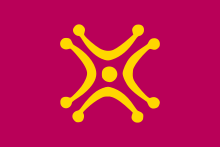Cantabrian labarum
 | |
| Name | Lábaru |
|---|---|
| Use |
Civil and state flag |
| Proportion | n/d |
| Adopted | March 15, 2016[1][2] [n 1][3] |
| Design | Purple cloth on which there is what would be called in heraldry a "saltire voided " made up of curved lines, with knobs at the end of each line. |
The Cantabrian labarum (Cantabrian: lábaru cántabru or Spanish: lábaro cántabro) is a modern interpretation of the ancient military standard known by the Romans as Cantabrum. It consists of a purple cloth on which there is what would be called in heraldry a "saltire voided " made up of curved lines, with knobs at the end of each line.
The name and design of the flag is in the theory advocated by several authors [4] of a relationship between the genesis of labarum and the military standard called Cantabrum, thereby identifying both as a same thing; and the alleged relationship the Codex Theodosianus established between the Labarum and the Cantabrarii, the school of Roman soldiers in charge of carrying the Cantabrum.
Additionally, and according to the definition of the Royal Academy of the Spanish language, labarum is the Roman standard (as in military ceremonial flag) on which, under Emperor Constantin's rule, the cross and the Monogram of Christ (XP: Chi-Rho) was drawn. By association of ideas, labarum can refer just to the monogram itself, or even just the cross.
Etymologically, the word comes from (p)lab- which means to speak in a number of Celtic languages, many of which have derivatives. For example, in Welsh llafar means "speech", "language", "voice". Ancient Cornish and Breton have lavar, "word", and ancient Irish has labrad: "language", "speech".[5]

Today, certain social and political groups in modern Spanish autonomous community of Cantabria advocate the use of this ancient standard along with the current flag.[6]
See also
References
- ↑ Boletín Oficial del Parlamento de Cantabria Página 2128 15 de marzo de 2016 Núm. 85
- ↑ El lábaro es reconocido como símbolo del pueblo cántabro
- ↑ "Actas y Acuerdos Municipales", Ayuntamiento de Comillas, July 2006
- ↑ Dictionnaire des antiquités grecques et romaines - Daremberg et Saglio 1920.
- ↑ Maroñas García, Jesús J. (1999). Onomástica de Cantabria. Los nombres cántabros de persona. Santander: Ed. C.D.E.S.C. pp. 89–90. ISBN 84-931031-0-1.
- ↑ EFE (May 2009), "ADIC presenta en el Parlamento una propuesta para oficializar el lábaro", El Diario Montañés.
Notes
External links
- History of the Labaro (Spanish)